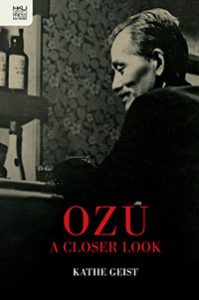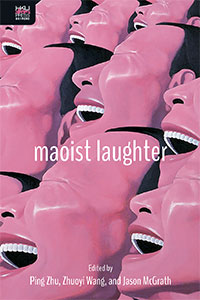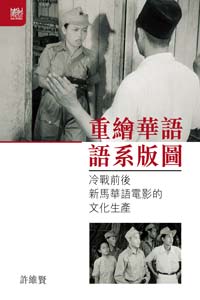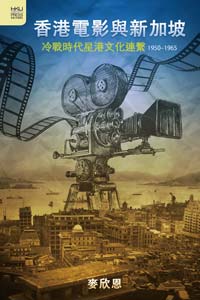Offer: 30% off apply to exhibit booklist with web link to our site (click the book cover)
Discount code: 30CP2022
Expire date: 30/6/2022
Year: 2022
Author: Kathe Geist
ISBN: 9789888754175
Based on a close reading of Japanese director Yasujiro Ozu’s extant films, this book provides insights into the ways the director created narrative structures and used symbolism to construct meaning in his films. Against critics’ insistence that Ozu was indifferent to plot and unlikely to use symbols, Geist demonstrates otherwise, revealing the director’s subtle iconographic paradigms. Her incisive understanding of the historical and cultural context in which the films were conceived amplifies her analysis of the films’ structure and meaning. Ozu: A Closer Look guides the reader through Ozu’s earliest silent films, his sound films made during the wartime period and subsequent American Occupation of Japan, and finally takes up specific themes relevant to his later, better-known films. These themes include religion, gender, and the influence of traditional Japanese painting. Geist also examines the impact that Ozu’s films had on specific directors in Europe, America, and Japan. Intended for film scholars, students, and fans of the director, this book provides fresh insights into the director’s films and new challenges in studies on Ozu.
Contents:
List of Illustrations
Introduction
Part I. The Silent Films
Chapter 1: The Gangster Films
Chapter 2: Signs, Symbols, and Motifs
Chapter 3: The Sound of Silence
Chapter 4: Narrative Strategies, Texts, and Subtexts
Afterword Part I: “. . . when the studio was in Kamata”
Part II. War and Peace: The Sound Films, 1936–1952
Chapter 5: The Calm
Chapter 6: The Storm
Chapter 7: The Reckoning
Afterword Part II: “Then it’s good we lost.”
Part III. Religion, Sex, and Other Matters
Chapter 8: Narratives Strategies in the Late Films
Chapter 9: Religion
Chapter 10: Gender Issues
Chapter 11: A Two-Dimensional Art Form
Chapter 12: The Ozu Touch: Influencing Others
Afterword Part III: But is it modern?
Plot Synopses
Selected Bibliography
Index
 Chinese Cinema: Identity, Power, and Globalization
Chinese Cinema: Identity, Power, and Globalization
Year: 2022
Editors: Jeff Kyong-McClain, Russell Meeuf, and Jing Jing Chang
ISBN: 9789888528530
In Chinese Cinema: Identity, Power, and Globalization, a variety of scholars explore the history, aesthetics, and politics of Chinese cinema as the Chinese film industry grapples with its place as the second largest film industry in the world. Exploring the various ways that Chinese cinema engages with global politics, market forces, and film cultures, this edited volume places Chinese cinema against an array of contexts informing the contours of Chinese cinema today. The book also demonstrates that Chinese cinema in the global context is informed by the intersections and tensions found in Chinese and world politics, national and international co-productions, the local and global in representing Chineseness, and the lived experiences of social and political movements versus screened politics in Chinese film culture. This work is a pioneer investigation of the topic and will inspire future research by other scholars of film studies.
Contents:
Acknowledgments
Introduction (Jeff Kyong-McClain, Russell Meeuf, and Jing Jing Chang)
I. Politics and Dissent in Global Contexts
1. Seeing (through) the Struggle Sessions: Cinema, Recycling, and
Transnational Circulation (Belinda Q. He)
2. Screening Politics in Hong Kong (Joseph Tse-Hei Lee)
3. “All of Us Are Part of the Monster”: Toxic Sublimity and Ethical Reflexivity
in Zhao Liang’s Behemoth (Man-Fung Yip)
II. Audiences and Reception in Transnational Contexts
4. From Gone with the Wind to The Spring River Flows East: Melodrama and Historical Imagination in Postwar Chinese Cinema (Kenny Kwok Kwan Ng)
5. Spatial Perception: The Aesthetics of Yijing in Transnational Kung Fu
Films (Xi Liu)
6. Global Network, Ecocinema, and Chinese Contexts: Wolf Totem as a Successful Model of Transnational Coproduction (Wendy Su)
III. Globalization and Chinese Identities
7. The Sound of Chinese Urban Cinema: Multilingualism and the Re-globalization of Shanghai in the 1990s (Lin Feng)
8. Sound, Allusion, and the “Wandering Songstress” in Royston Tan’s Films (Alison M. Groppe)
9. Implicit Sexuality: The Representation of the Femme Fatale Figure in Black Coal, Thin Ice (Yushi Hou)
IV. Film Markets and Financial Reform
10. The China Film Co., Ltd. and the Stock Market: Financialization with
Chinese Characteristics (Shiying Liu)
11. Big Shot’s Funeral: Sino-Foreign Collaboration and Industrial Commercialization (Qi Ai)
12. Sticks, Not Carrots: The Discourse of Soft Power in Popular Chinese
Cinema (Katherine Chu)
Epilogue (Po-Shek Fu and Stanley Rosen)
List of Contributors
Index
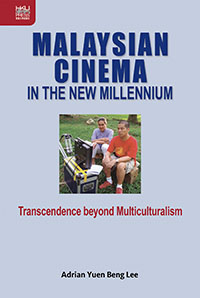 Malaysian Cinema in the New Millennium: Transcendence beyond Multiculturalism
Malaysian Cinema in the New Millennium: Transcendence beyond Multiculturalism
Year: 2022
Author: Adrian Yuen Beng Lee
ISBN: 9789888528523
Malaysian Cinema in the New Millennium offers a new approach to the study of multiculturalism in cinema by analysing how a new wave of filmmakers champion cultural diversity using cosmopolitan themes. Adrian Lee offers a new inquiry of Malaysian cinema that examines how the ‘Malaysian Digital Indies’ (MDI) have in recent years repositioned Malaysian cinema within the global arena. The book shines a new light on how politics and socioeconomics have influenced new forms and genres of the post-2000s generation of filmmakers, and provides a clear picture of the interactions between commercial cinema and politics and socioeconomics in the first two decades of the new millennium. It also assesses how the MDI movement was successful in creating a transnational cinema by displacing and deterritorialising itself from the context of the national, and illustrates how MDI functions as a site for questioning and proposing a new national identity in the era of advanced global capitalism and new Islamisation. Covering all these interrelated topics, Lee’s book is a pioneering and comprehensive work in the study of Malaysian cinema in the recent decades.
Contents:
List of Figures
Acknowledgements
Introduction: The Malaysian Digital Indies and a Cinema beyond Multiculturalism: New Forms, Aesthetics, and Genres in post-2000 Malaysian Cinema
1. The Malaysian Digital Indies (MDI): Transnational Malaysian Cinema, Problematising the National
2. The Malaysian Digital Indies: A Digital Independent Transnational Cinema
3. ‘Beyond Multiculturalism’: The Malaysian Postethnic Cosmopolitan Cinema
4. ‘The Malaysian Decade of Horror’: The Malaysian Horror Renaissance
5. Conclusion: Towards the Fourth Phase of Malaysian Cinema
Filmography: Malaysian Films
Filmography: Non-Malaysian Films
Appendix I: Database for the Malaysian Digital Indies, 2000–2011
Appendix II: Database for Commercial Mainstream Films in Post-2000 Malaysian Cinema, 2000–2011
Appendix III: Database for Horror Films in Post-2000 Malaysian Cinema, 2000–2011
References
Index
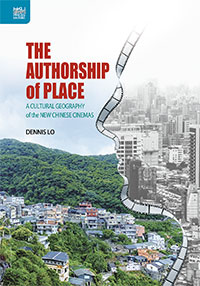 The Authorship of Place: A Cultural Geography of the New Chinese Cinemas
The Authorship of Place: A Cultural Geography of the New Chinese Cinemas
Year: 2020
Author: Dennis Lo
ISBN: 9789888528516
The Authorship of Place is the first monograph dedicated to the study of the politics, history, aesthetics, and practices of location shooting for Taiwanese, Mainland Chinese, and coproduced art cinemas shot in rural communities since the late 1970s. Dennis Lo argues that rural location shooting, beyond serving aesthetic and technical needs, constitutes practices of cultural survival in a region beset with disruptive and disorienting social changes, including rapid urbanization, geopolitical shifts, and ecological crises. In response to these social changes, auteurs like Hou Xiaoxian, Jia Zhangke, Chen Kaige, and Li Xing engaged in location shooting to transform sites of film production into symbolically meaningful places of collective memories and aspirations. These production practices ultimately enabled auteurs to experiment with imagining Taiwanese, Mainland Chinese, and cross-strait communities in novel and contentious ways. Deftly guiding readers on a cross-strait tour of prominent shooting locations for the New Chinese Cinemas, this book shows how auteurs sought out their disappearing cultural heritage by reenacting lived experiences of nation building, homecoming, and cultural salvage while shooting on-location. This was an especially daunting task when auteurs encountered the shooting locations as spaces of unresolved historical, social, and geopolitical contestations, tensions which were only intensified by the impact of filmmaking on rural communities. This book demonstrates how these complex circumstances surrounding location shooting were pivotal in shaping both representations of the rural on-screen, as well as the production communities, institutions, and industries off-screen. Informed by cutting-edge perspectives in cultural geography and media anthropology, The Authorship of Place both revises Chinese-language film history and theorizes groundbreaking approaches for investigating the cultural politics of film authorship and production.
Contents:
List of Illustrations
Acknowledgments
Introduction: Film Authorship as Place Making
Part 1: Nation Building
1. Appreciate from Afar: Longing for Home in Li Xing’s and Wang Tong’s Xiangtu Film Adaptations
2. Myth Making in Place: Cultivating the Wilderness with Li Xing and Wu Tianming
Part 2: Homecoming
3. Reel Pilgrims: Experiencing Life with Chen Kaige
4. A Home in Becoming: Forging Taiwan’s Imagined Community in Jiufen
Part 3: Salvage
5. Hou Xiaoxian as Ambassador: Performing Cross-Strait Histories in the
“Taiwan Trilogy”
6. Translocalities of Sadness: Touring Inauthentic Geographies with Hou Xiaoxian and Jia Zhangke
Conclusion: Place and the Politics of Nation Branding
References
Index
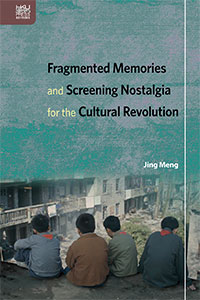 Fragmented Memories and Screening Nostalgia for the Cultural Revolution
Fragmented Memories and Screening Nostalgia for the Cultural Revolution
Year: 2020
Author: Jing Meng
ISBN: 9789888528462
Fragmented Memories and Screening Nostalgia for the Cultural Revolution argues that films and TV dramas about the Cultural Revolution made after China’s accession to the WTO in 2001 tend to represent personal memories in a markedly sentimental, nostalgic, and fragmented manner. This new trend is a significant departure from earlier films about the subject, which are generally interpreted as national allegories, not private expressions of grief, regret or other personal feelings. With China entering a postsocialist era, the ideological conflation of socialism and global capitalism has generated enough cultural ambiguity to allow a space for the expression of personalized reminiscences of the past. By presenting these personal memories—in effect alternative narratives to official history—on screen, individuals now seem to have some agency in narrating and constructing history. At the same time such autonomy can be easily undermined since the promotion of the sentiment of nostalgia is often subjected to commodification. Sentimental treatments of the past may simply be a marketing strategy. Underplaying political issues is also a ‘safer’ way for films and TV dramas to secure public release in mainland China. Meng concludes that the new mode of representing the past is shaped by the current sociopolitical conditions: these personal memories and micro-narratives can be understood as the defining ways of remembering in China’s postsocialist era.
Contents:
List of Illustrations
Acknowledgements
Introduction
1. Janus-Faced Nostalgia: Moral Critique, Sentimentalism, and Gender
2. Post-revolution Nostalgia: Memory as Performance
3. Beyond Nostalgia: Agency and Auteuristic Expressivity in Fragmented Memories
4. Post-trauma Narrative: Fragmented Past Flows into the Present
5. A Collective ‘I’ and Its Contending Readings: Personal Memories in
Sent-Down Youth
6. Conclusion: Contingent Memories, Contested Modernities
Filmography
Bibliography
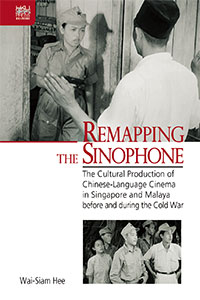 Remapping the Sinophone: The Cultural Production of Chinese-Language Cinema in Singapore and Malaya before and during the Cold War
Remapping the Sinophone: The Cultural Production of Chinese-Language Cinema in Singapore and Malaya before and during the Cold War
Year: 2019
Author: Wai-Siam Hee
ISBN: 9789888528035
In a work that will force scholars to re-evaluate how they approach Sinophone studies, Wai-Siam Hee demonstrates that many of the major issues raised by contemporary Sinophone studies were already hotly debated in the popular culture surrounding Chinese-language films made in Singapore and Malaya during the Cold War. Despite the high political stakes, the feature films, propaganda films, newsreels, documentaries, newspaper articles, memoirs, and other published materials of the time dealt in sophisticated ways with issues some mistakenly believe are only modern concerns. In the process, the book offers an alternative history to the often taken-for-granted versions of film and national history that sanction anything relating to the Malayan Communist Party during the early period of independence in the region as anti-nationalist.
Drawing exhaustively on material from Asian, European, and North American archives, the author unfolds the complexities produced by British colonialism and anti-communism, identity struggles of the Chinese Malayans, American anti-communism, and transnational Sinophone cultural interactions. Hee shows how Sinophone multilingualism and the role of the local, in addition to other theoretical problems, were both illustrated and practised in Cold War Sinophone cinema. Remapping the Sinophone: The Cultural Production of Chinese-Language Cinema in Singapore and Malaya before and during the Cold War deftly shows how contemporary Sinophone studies can only move forward by looking backwards.
Contents:
List of Illustrations
Acknowledgments
Introduction
1. New Friend: A Sinophone Perspective on the First Locally Produced Film
in Singapore and Malaya
2. Malayan Chinese Popular Memory: The Shaw Brothers Chinese-Language Films Directed by Wu Cun in Singapore
3. The Making of Malaya: On the Malayan Film Unit’s Cold War Moving
Images
4. A Singapore Story, Hollywood Version: US Government Anti-Communist Films Produced in Singapore and Malaya
5. Malayanised Chinese-Language Cinema: On Yi Shui’s Cinematic Practice
and Third World Film
Afterword
Appendix: Filmography of Early Mandarin and Chinese Topolects Singapore- Malayan Cinema (1927–1965)
List of Chinese Names and Terms
References
Index
 Indonesian Cinema after the New Order: Going Mainstream
Indonesian Cinema after the New Order: Going Mainstream
Year: 2019
Author: Thomas Barker
ISBN: 9789888528073
In Indonesian Cinema after the New Order: Going Mainstream, Thomas Barker presents the first systematic and most comprehensive history of contemporary Indonesian cinema. The book focuses on a 20-year period of great upheaval from modest, indie beginnings, through mainstream appeal, to international recognition. More than a simple narrative, Barker contributes to cultural studies and sociological research by defining the three stages of an industry moving from state administration; through needing to succeed in local pop culture, specifically succeeding with Indonesian youth, to remain financially viable; until it finally realizes international recognition as an art form. This “going mainstream” paradigm reaches far beyond film history and forms a methodology for understanding the market in which all cultural industries operate, where the citizen-consumer (not the state) becomes sovereign.
Indonesia presents a particularly interesting case because “going mainstream” has increasingly meant catering to the demands of new Islamic piety movements. It has also meant working with a new Ministry of Tourism and Creative Economy, established in 2011. Rather than a simplified creative world many hoped for, Indonesian filmmaking now navigates a new complex of challenges different to those faced before 1998. Barker sees this industry as a microcosm of the entire country: democratic yet burdened by authoritarian legacies, creative yet culturally contested, international yet domestically shaped.
Contents:
List of Illustrations
Acknowledgments
Introduction: Indonesian Cinema after Authoritarianism
1. Indonesian Cinema before Reformasi
2. From Indie to Mainstream
3. Horrifying Youth
4. Marrying Islam and Pop Culture
5. Audiences without Cinemas
6. Producing an Oligopoly
7. Friction: Society, Censorship, and Government Policy
Conclusion: Indonesian Cinema as Pop Culture
Bibliography
Index
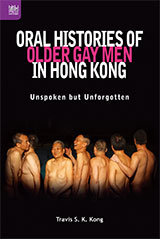 Oral Histories of Older Gay Men in Hong Kong: Unspoken but Unforgotten
Oral Histories of Older Gay Men in Hong Kong: Unspoken but Unforgotten
Year: 2019
Author: Travis S. K. Kong
ISBN: 9789888528066
“This is very personal and private, but I’ve told you everything.” Old Chan thus gives voice to the attitude expressed in all thirteen stories told in this intimate oral history of life at the margins of Hong Kong society, stories punctuated by laughter, joy, happiness, and pride, as well as tears, anger, remorse, shame, and guilt. Illustrated with photos, letters, and other images, Oral Histories of Older Gay Men in Hong Kong: Unspoken but Unforgotten gives voice to the complexities of a “secretive” past with unique hardships as these men came to terms with their sexuality, adulthood, and a colonial society. The men talk with equal candour about how their sexuality remains a complication as they negotiate failing health, ageing, and their current role in society. While fascinating as life histories, these stories also add insight to the theoretical debates surrounding identity and masculinity, coming out, ageing and sexuality, and power and resistance. Confined within the heteronormative culture prescribed by government, family, and religion, these men have lived the whole of their lives struggling to find their social role, challenging the distinction between public and private, and longing for a stable homosexual relationship and a liberating homosexual space in the face of deteriorating health and a youth-obsessed gay community.
Contents:
Preface and Acknowledgements
Note on Romanization
Introduction
1. Old Chan: Brokeback below the Lion Rock (1924–2013)
2. Brother Ming: Who Says There Are No Communist Tongzhi? (1935–2010)
3. Shmily: A Butterfly with 1,500 Male Lovers (1949–)
4. David: A Charming Liar (1946–)
5. Robert: A Banished Expatriate Officer in the Royal Hong Kong Police (1947–)
6. Jonathan: A Gay Gambler Who Turned over a New Leaf (1948–)
Letters Provided by Interviewees
Photo Exhibition of An Oral History of Older Gay Men in Hong Kong (2014)
7. Uncle Lee: A Sunset Tongzhi (1940–2016)
8. May Wu: A Divine Woman’s Poisons of Ignorance, Attachment, and Aversion (1940–)
9. Brother Shing: Only Men Understand Me (1944–)
10. Uncle Leung: A Lifelong Libertine Who ‘Queered’ around Hong Kong, Macao, and Canton (1945–)
11. Tommy: A Bisexual Butterfly (1949–)
12. Tony: The Bear Chaser (1950–)
13. Nigel Collett: A History Boy, a Military Man, a Writer, and an Activist (1952–)
Conclusion: Transformation of an Academic Project into Participatory
Action Research
Glossary
Maps
References
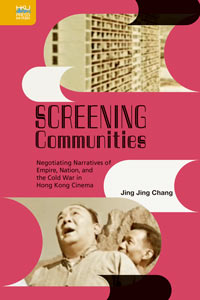 Screening Communities: Negotiating Narratives of Empire, Nation, and the Cold War in Hong Kong Cinema
Screening Communities: Negotiating Narratives of Empire, Nation, and the Cold War in Hong Kong Cinema
Year: 2019
Author: Jing Jing Chang
ISBN: 9789888455768
Postwar Hong Kong cinema played an active role in building the colony’s community in the 1950s and 1960s. To Jing Jing Chang, the screening of movies in postwar Hong Kong was a process of showing the filmmakers’ visions for Hong Kong society and simultaneously an attempt to conceal their anxieties and mask their political agenda. It was a time when the city was a site of intense ideological struggles among the colonial government, Chinese Nationalists, and Communist sympathizers. The medium of film was recognized as a powerful tool for public persuasion and various camps competed to win over the hearts and minds of the audience. Screening Communities thus situates the history of postwar Hong Kong cinema at the intersection of Cold War politics, Chinese culture, and local society.
Focusing on the genres of official documentary film, leftist family melodrama (lunlipian), and youth film, this study examines the triangulated relationship of colonial interventions in Hong Kong film culture, the rise of left-leaning Cantonese directors as new cultural elites, and the positioning of audiences as contributors to the colony’s journey toward industrial modernity. Filmmakers are shown having to constantly negotiate changing sociopolitical conditions: the Hong Kong government presenting itself as a collaborative ruling body, moral and didactic messages being adapted for commercial releases, and women becoming recognized as a driving force behind Hong Kong’s postwar industrial success. In putting forward a historical narrative that privileges the poetics and politics of shaping a local community through a continuous screening process, Screening Communities offers a new interpretation of the development of Hong Kong cinema—one that breaks away from the usual accounts of the “rise and fall” of the industry.
Contents:
List of Illustrations
Acknowledgments
Introduction
Part 1. Toward a Colonial Modernity: From Imperial Legacy to Colonial Politics
1. Film Censorship and the Regulatory Context of Postwar
Hong Kong
2. Between Idealism and Pragmatism: Postwar Hong Kong’s Official Film Culture
Part 2. Toward a Leftist Vernacular Modernism: From the National to the Familial
3. May Fourth and Postwar Hong Kong’s Leftist Cantonese Cinema
4. Familial Address and the Aesthetics of Lunli
Part 3. Toward a Gendered Industrialized City: From a Borderless to a Localized Place
5. The Nanyang Ethos and Engendering the Chinese Overseas Experience
6. Girls in Masquerade: Celebrity Culture and Fandom in 1960s
Hong Kong Youth Film
Coda: The Persistence of Screening Community in Post–Cold War
Hong Kong
Glossary
Notes
Filmography
Bibliography
Index
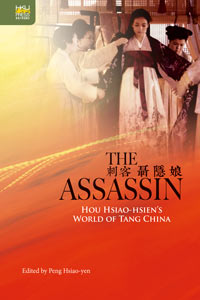 The Assassin: Hou Hsiao-hsien’s World of Tang China
The Assassin: Hou Hsiao-hsien’s World of Tang China
Year: 2019
Editor: Peng Hsiao-yen
ISBN: 9789888455690
The Assassin tells the story of a swordswoman who refrains from killing. Hou Hsiao-hsien astonishes his audience once again by upsetting almost every convention of the wuxia (martial arts) genre in the film. This collection offers eleven readings, each as original and thought-provoking as the film itself, beginning with one given by the director himself. Contributors analyze the elliptical way of storytelling, Hou’s adaptation of the source text (a tale from the Tang dynasty, also included in this volume), the film’s appropriation of traditional Chinese visual aesthetics, as well as the concept of xia (knight-errant) that is embedded in Confucian, Daoist, and Buddhist worldviews. There are also discussions of the much-celebrated sonic design of The Assassin: the nearly exclusive use of a diegetic film score is a statement on the director’s belief in cinematic reality.
Underlying all the chapters is a focus on how Hou reinvents Tang-dynasty China in contemporary culture. The meticulously recreated everyday reality of the Tang world in the film highlights the ethnic and cultural diversity of the dynasty. It was a time when Sogdian traders acted as important intermediaries between Central Asia and the Tang court, and as a result Sogdian culture permeated the society.
Taking note of the vibrant hybridity of Tang culture in the film, this volume shows that the historical openness to non-Chinese elements is in fact an essential part of the Chineseness expressed in Hou’s work. The Assassin is a gateway to the remote Tang-dynasty world, but in Hou’s hands the concerns of that premodern world turn out to be highly relevant to the world of the audience.
Contents:
List of Illustrations
Character Chart
Chronicle of Major Events in the Film Story before the Film Begins
Map of the Tang after the An Lushan Rebellion (763)
Acknowledgments
Introduction (Peng Hsiao-yen)
Section 1: The Auteur Speaking and Auteurism Revisited
1. The Screen Frame Is Only a Faintly Discernable Existence in the Real World: An Interview with Hou Hsiao-hsien and Xie Haimeng by Yang Zhao (Translated by Christopher Lupke)
2. To Kill or Not to Kill: Auteurism and Storytelling (Peng Hsiao-yen)
Section 2: Literary and Film Adaptation and Editing
3. The Assassin and Heibai Wei: Two Dramatic Adaptations of
“Nie Yinniang” (Yuan-ju Liu and Peng Hsiao-yen)
4. The Assassin as Adaptation and Transmedia Practice (Tze-lan Deborah Sang)
Section 3: Sight and Sound
5. Visuality and Music in The Assassin: The Tang World Recreated (Peng Hsiao-yen)
6. The Three Ears of The Assassin (Timmy Chih-ting Chen and Hsiao-hung Chang)
7. Veiled Listening: The Assassin as an Eavesdropper (Nicole Huang)
8. Sounding against the Grain: Music, Voice, and Noise in The Assassin (James A. Steintrager)
Section 4: Xia and Traditional Worldviews
9. The Martial Arts of Nostalgia: Sentimentalism and Modernity
Overcome in The Assassin (Jen-Hao Walter Hsu)
10. Ethics and Aesthetics in The Assassin (Hsiu-Chuang Deppman)
11. The Something of Nothing: Buddhism and The Assassin (Victor Fan)
Appendix 1: Pei Xing, “Nie Yinniang”
Appendix 2: “Nie Yinniang” (Translated by Pedro Acosta)
Filmography
Works Cited
Contributors
Index
Year: 2018
Editors: Ping Zhu, Zhuoyi Wang, and Jason McGrath
ISBN: 9789888528011
During the Mao years, laughter in China was serious business. Simultaneously an outlet for frustrations and grievances, a vehicle for socialist education, and an object of official study, laughter brought together the political, the personal, the aesthetic, the ethical, the affective, the physical, the aural, and the visual. The ten essays in Maoist Laughter convincingly demonstrate that the connection between laughter and political culture was far more complex than conventional conceptions of communist indoctrination can explain. Their sophisticated readings of a variety of genres—including dance, cartoon, children’s literature, comedy, regional oral performance, film, and fiction—uncover many nuanced innovations and experiments with laughter during what has been too often misinterpreted as an unrelentingly bleak period. In Mao’s China, laughter helped to regulate both political and popular culture and often served as an indicator of shifting values, alliances, and political campaigns. In exploring this phenomenon, Maoist Laughter is a significant correction to conventional depictions of socialist China.
Contents:
List of Figures
Acknowledgments
Introduction: The Study of Laughter in the Mao Era (Ping Zhu)
Part I: Utopian Laughter
1. Laughter, Ethnicity, and Socialist Utopia: Five Golden Flowers (Ban Wang)
2. Revolution Plus Love in Village China: Land Reform as Political
Romance in Sanliwan Village (Charles A. Laughlin)
3. Joking after Rebellion: Performing Tibetan-Han Relations in the Chinese Military Dance “Laundry Song” (1964) (Emily Wilcox)
Part II: Intermedial Laughter
4. Intermedial Laughter: Hou Baolin and Xiangsheng Dianying in Mid-1950s China (Xiaoning Lu)
5. Fantastic Laughter in a Socialist-Realist Tradition? The Nuances of “Satire” and “Extolment” in The Secret of the Magic Gourd and Its 1963 Film Adaptation (Yun Zhu)
6. Humor, Vernacularization, and Intermedial Laughter in Maoist Pingtan (Li Guo)
Part III: Laughter and Language
7. Propaganda, Play, and the Pictorial Turn: Cartoon (Manhua Yuekan), 1950–1952 (John A. Crespi)
8. The Revolutionary Metapragmatics of Laughter in Zhao Shuli’s Fiction (Roy Chan)
9. Huajixi, Heteroglossia, and Maoist Language (Ping Zhu)
10. Ma Ji’s “Ode to Friendship” and the Failures of Revolutionary Language (Laurence Coderre)
Bibliography
List of Contributors
Index
 Metacinema in Contemporary Chinese Film
Metacinema in Contemporary Chinese Film
Year: 2018
Author: G. Andrew Stuckey
ISBN: 9789888390816
Depictions within a movie of either filmmaking or film watching are hardly novel, but the dramatic expansion of the reach of the metacinematic into contemporary Chinese cinemas is nothing short of remarkable. To G. Andrew Stuckey, the prevalence of metacinematic features forms the basis of a discourse on film arising from the films themselves. Such a discourse, in turn, outlines the boundaries of the possible for film in China as aesthetic or sociopolitical practice. Metacinema also draws our attention to the presence of the audience, people actively responding to a film. In elucidating the affective responses elicited by the metacinematic mode in the viewers, Stuckey argues that metacinema reflects ways of being in the world that audiences may take up for themselves.
The films studied in this book are drawn across the full spectrum of Chinese films made in mainland China, Hong Kong, and Taiwan during the 1990s and 2000s, from award-winning conceptual art films to popular crowd pleasers, blockbusters to low-budget productions, and documentary-style social realist exposé projects to studio assembly-line investments. The recurrence of the metacinematic across this broad range of works is indicative of its relevance to Chinese films today, and the analysis of these diverse examples allows us to gauge the cultural, social, and aesthetic implications of Chinese cinemas as a whole.
Contents:
Acknowledgments Note on Romanization
1. Introduction
2. Production: The Global Musical and Perhaps Love
3. Consumption: Genre and Quotation in Goodbye, Dragon Inn
4. True Lies: Authority, Authenticity, and Authorship in In the Heat of
the Sun and Suzhou River
5. Documentarization and Amplified Realism in Jia Zhangke’s Films
6. Beyond Allegory: Symbol and the Family Melodrama in Lost in Beijing
7. Conclusion
Notes
Filmography
Bibliography
Index
Year: 2018
Author: 許維賢
ISBN: 9789888528004
本書從冷戰前後的歷史語境,探討多個帝國角力下以中國為邊界的新馬華語語系世界,重寫備受學界忽略的早期新馬華語電影文化,並聚焦探討1926至1965年新馬的華語影人如何透過反帝反殖的話語回應冷戰前後的意識形態。通過發掘和分析冷戰年代英美殖民政府的解密檔案與反共電影,以及全面收集整理早期中英書報刋物對電影文化的報導,本書從新馬的人民記憶和官方記憶的多重角度雙向探討華人在冷戰中所扮演的角色,不但還原「華語」和「華語電影」在新馬的原初記憶,也從視聽的大眾傳播層面反思新馬華人的文化生產、本土意識、國家認同與華人認同的糾葛及其演變。
Contents:
圖 片
謝 辭
導 論
一、研究目的
二、「華語電影」的系譜
三、重繪華語語系版圖:前世今生 四、冷戰前後:從華人性到華人認同的改造
五、章節概述
第一章 《新客》:從華語語系論新馬本土生產的首部電影
一、《新客》有沒有出品?
二、《新客》的出品證據及其成敗
三、劉貝錦:生為別世之人,死為異域之鬼
四、作為弱勢語言研究的華語語系
五、《新客》的華夷風
六、《新客》的揉雜化和華人性
第二章 人民記憶、華人性和女性移民:以吳村的馬華電影為中心
一、人民記憶:馬華電影與馬華文學
二、國族主義:華人性可以度量嗎?
三、女性移民、遺民和夷民
四、獨身主義、瘋婦與華人性
五、馬華文藝獨特性、馬共與「非馬非華」
第三章 打造馬來亞:論英屬馬來亞製片組的冷戰影像
一、馬來亞製片組
二、打造馬來亞:帝國的終結?
三、反共影像和冷戰意識形態
四、「現代化」的意識形態及其和解方案
第四章 新加坡故事,好萊塢版本:論冷戰時期美國政府在新馬製作的反共電影
一、全球真理運動
二、《小村烽火》:馬來亞人民 vs 馬共分子
三、《星嘉坡故事》:「我們的新前途,就是新中國」?
四、其他反共電影和冷戰東方主義
第五章 馬來亞化華語電影:論易水的電影實踐與第三世界電影
一、華語電影與易水
二、「多種華語」的重層脈絡
三、第三世界電影:馬化華語電影
四、《獅子城》和《黑金》:易水的電影實踐
五、馬化華語電影的得失成敗
餘 論
附錄:早期新馬華語方言電影片目(1927–1965)
引用文獻
論文發表出處
Year: 2018
Author: 麥欣恩
ISBN: 9789888390656
在1950年代,冷戰形勢令中國門戶對外關閉,香港取代上海成為最重要的華文電影製作中心。新加坡與香港均位於竹幕中國之外,構築了「海外華人」的共同屬性。香港與星馬當時同為英國殖民地,兩地在政治及軍事體制上形成連帶;在文化上,星馬地區是那個年代香港電影及文藝作品最大的市場,冷戰時代的香港電影往往呈現出對於星馬地區猶如親屬般親密的「文化想像」,一條「電影文化環」就這樣把星港聯繫起來。本書採取文化史分析角度,兼具電影文本細讀,探討電懋(國泰)、光藝兩間片廠所製作的六部星馬題材電影,重新檢視這道星港電影文化環的形成和斷裂的先兆,以及香港電影的主體性如何透過他者的凝視而孵生。
Contents:
圖 片
序——容世誠教授
鳴 謝
第一單元
第一章 導言:「香港電影」與冷戰舞台
第二章 香港總督葛量洪爵士的兩封信:二戰後英國提升香港的
政經地位
第三章 商業電影的背後:從四種建制看商業與政治的互動關係
第二單元
第四章 星港雙城記:從(國泰)電懋的兩部電影看星港文化環的生成
第五章 總有親屬在「唐山」:光藝「南洋三部曲」所展現的海外
廣東文化樞紐
第六章 從新聯兩部作品看香港左派粵語電影對「南洋僑胞」之
「文藝任務」
第七章 星港文化環斷裂先兆:《獅子城》展現的新加坡民族電影雛型
結語:再現南洋、再見南洋
參考書目
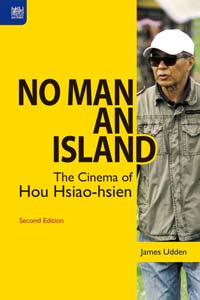 No Man an Island: The Cinema of Hou Hsiao-hsien, Second Edition
No Man an Island: The Cinema of Hou Hsiao-hsien, Second Edition
Year: 2017
Author: James Udden
ISBN: 9789888139224
Taiwan is a peculiar place resulting in a peculiar cinema, with Hou Hsiao-hsien being its most remarkable product. Hou’s signature long and static shots almost invite critics to give auteurist readings of his films, often privileging the analysis of cinematic techniques at the expense of the context from which Hou emerges. In this pioneering study, James Udden argues instead that the Taiwanese experience is the key to understanding Hou’s art. The convoluted history of Taiwan in the last century has often rendered fixed social and political categories irrelevant. Changing circumstances have forced the people in Taiwan to be hyperaware of how imaginary identity—above all national identity—is. Hou translates this larger state of affairs in such masterpieces as City of Sadness, The Puppetmaster, and Flowers of Shanghai, which capture and perhaps even embody the elusive, slippery contours of the collective experience of the islanders. Making extensive uses of Chinese sources from Taiwan, the author shows how important the local matters for this globally recognized director.
In this new edition of No Man an Island, James Udden charts a new chapter in the evolving art of Hou Hsiao-hsien, whose latest film, The Assassin, earned him the Best Director Award at the Cannes Film Festival in 2015. Hou breaks new ground in turning the classic wuxia genre into a vehicle to express his unique insight into the working of history. The unconventional approach to conventions is quintessential Hou Hsiao-hsien.
Contents:
Foreword by Chu Tien-wen: Reading No Man an Island
Acknowledgments
Introduction: The Problem of Hou Hsiao-hsien
1. Hou and the Taiwanese Experience
2. Hou and the Taiwanese New Cinema
3. History in Its Place: City of Sadness (1989) and The Puppetmaster
(1993)
4. Goodbye to All That: The New Hou from Good Men, Good
Women (1995) to Flowers of Shanghai (1998)
5. Hou in the New Millennium
Updated Conclusion: Hou Hsiao-hsien and The Assassin (2015)
Notes
Bilingual Filmography and Glossary
Selected Bibliography
Index
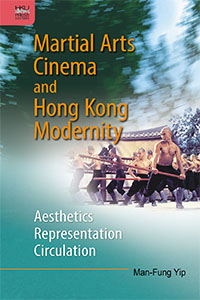 Martial Arts Cinema and Hong Kong Modernity: Aesthetics, Representation, Circulation
Martial Arts Cinema and Hong Kong Modernity: Aesthetics, Representation, Circulation
Year: 2017
Author: Man-Fung Yip
ISBN: 9789888390717
At the core of Martial Arts Cinema and Hong Kong Modernity: Aesthetics, Representation, Circulation is a fascinating paradox: the martial arts film, long regarded as a vehicle of Chinese cultural nationalism, can also be understood as a mass cultural expression of Hong Kong’s modern urban-industrial society. This important and popular genre, Man-Fung Yip argues, articulates the experiential qualities, the competing social subjectivities and gender discourses, as well as the heightened circulation of capital, people, goods, information, and technologies in Hong Kong of the 1960s and 1970s. In addition to providing a novel conceptual framework for the study of Hong Kong martial arts cinema and shedding light on the nexus between social change and cultural/aesthetic form, this book offers perceptive analyses of individual films, including not only the canonical works of King Hu, Chang Cheh, and Bruce Lee, but also many lesser-known ones by Lau Kar-leung and Chor Yuen, among others, that have not been adequately discussed before. Thoroughly researched and lucidly written, Yip’s stimulating study will ignite debates in new directions for both scholars and fans of Chinese-language martial arts cinema.
Contents:
Acknowledgments
Notes on Transliteration
Introduction: Martial Arts Cinema and Hong Kong Modernity
1. Body Semiotics
2. In the Realm of the Senses
3. Myth and Masculinity
4. The Difficulty of Difference
5. Marginal Cinema, Minor Transnationalism
Epilogue
Filmography
Bibliography
Index
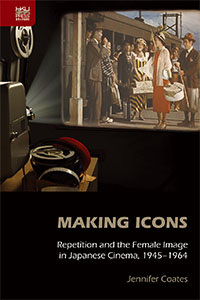 Making Icons: Repetition and the Female Image in Japanese Cinema, 1945–1964
Making Icons: Repetition and the Female Image in Japanese Cinema, 1945–1964
Year: 2016
Author: Jennifer Coates
ISBN: 9789888208999
One distinctive feature of post-war Japanese cinema is the frequent recurrence of imagistic and narrative tropes and formulaic characterizations in female representations. These repetitions are important, Jennifer Coates asserts, because sentiments and behaviours forbidden during the war and post-war social and political changes were often articulated by or through the female image. Moving across major character types, from mothers to daughters, and schoolteachers to streetwalkers, Making Icons studies the role of the media in shaping the attitudes of the general public. Japanese cinema after the defeat is shown to be an important ground where social experiences were explored, reworked, and eventually accepted or rejected by the audience emotionally invested in these repetitive materials.
An examination of 600 films produced and distributed between 1945 and 1964, as well as numerous Japanese-language sources, forms the basis of this rigorous study. Making Icons draws on an art-historical iconographic analysis to explain how viewers derive meanings from images during this peak period of film production and attendance in Japan.
Contents:
List of Illustrations
Acknowledgements
Notes on the Romanization of Japanese Words
Introduction
- Affect and the Spectator
- From Emotion, through Affect, to Fantasy
- Communal Fantasies: Making Meaning and Memory through Film
- Women in Post-war Japan
- Reading the Female Image: An Iconographic Approach
- Chapter Outline
Chapter 1 Post-war Stars and the Japanese Studio System
- Stars and the Studios
- Compliance and Conflict in the Studios: The Tōhō Strikes
- Affect and Aspiration: The Star Persona of Hara Setsuko
- Misora Hibari, Yamaguchi Yoshiko, and the ‘New Faces’
Chapter 2 The Suffering Mother Trope
- Suffering Mothers versus Modern Housewives
- Historical Contexts: Changing Japan from the Family Level Up
- From Victim to Victimizer: Changes in the Mother Image
Chapter 3 Post-war Housewives and the Tsuma-mono
- The Historical Development of the Post-war Housewife
- Early Housewives on Screen: A Hen in the Wind
- A New Approach: Hybrid Mother/Wife Characters in the 1960s
Chapter 4 Schoolgirls and Bourgeois Daughters
- The ‘New Life’ Discourses of the Early Post-war
- Shōjo Onscreen
- Shōjo and Suffering: The Hiroshima Maidens and Atomic Discourse
- Shōjo Sexuality: Hope and Rebirth
Chapter 5 Women in the Public Sphere
- Staying Positive: Hope and Healing in the Nurse and Schoolteacher
Tropes - The Affect of the Modern: The Moga Motif as Threat and Promise
Chapter 6 Theorizing Excess and the Abject
- Abject Bodies and National Identities
- Abject Imagery and the Schizophrenic Spectator
Chapter 7 Bodies of Excess
- The Panpan Motif as Unbounded Body
- Unbounded Stars and Abject Characters
- The Abject as Sublime
- Reflections of Horror
Conclusion
Select Filmography
Bibliography
Index
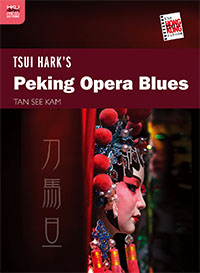 Tsui Hark’s Peking Opera Blues
Tsui Hark’s Peking Opera Blues
Year: 2016
Author: Tan See Kam
ISBN: 9789888208869
Part historical drama, part thriller, and part comedy, Tsui Hark’s Peking Opera Blues (1986) invites—if not demands—examinations from multiple perspectives. Tan See Kam rises to the challenge in this study by first situating Tsui in a Sinophone context. The diasporic director explores different dimensions of “Chineseness” in the film by depicting competing versions of Chinese nationalism and presenting characters speaking two Chinese languages, Cantonese and Mandarin. In the process he compels viewers to recognize the multiplicities of the Chinese identity and rethink what constitutes cultural Chineseness.
Contents:
List of Illustrations
List of Tables
Series Preface
Acknowledgments
Introduction: Setting the Scene
Act 1 Story and Structure
Act 2 Warlords, History, and the Democratic Dream
Act 3 Shanghai and Peking Blues: Fiction as Imagined History
Act 4 The Shadowplay of Attractions and Painted Faces
Act 5 Three-Women Fiction, Mandarin Ducks and Butterflies
Postscript
Credits
Glossary
Filmography
Bibliography
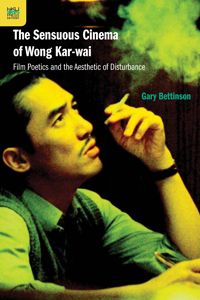 The Sensuous Cinema of Wong Kar-wai: Film Poetics and the Aesthetic of Disturbance
The Sensuous Cinema of Wong Kar-wai: Film Poetics and the Aesthetic of Disturbance
Year: 20104
Author: Gary Bettinson
ISBN: 9789888139293
The widely acclaimed films of Wong Kar-wai are characterized by their sumptuous yet complex visual and sonic style. This study of Wong’s filmmaking techniques uses a poetics approach to examine how form, music, narration, characterization, genre, and other artistic elements work together to produce certain effects on audiences. Bettinson argues that Wong’s films are permeated by an aesthetic of sensuousness and “disturbance” achieved through techniques such as narrative interruptions, facial masking, opaque cuts, and other complex strategies. The effect is to jolt the viewer out of complete aesthetic absorption. Each of the chapters focuses on a single aspect of Wong’s filmmaking. The book also discusses Wong’s influence on other filmmakers in Hong Kong and around the world.
The Sensuous Cinema of Wong Kar-wai will appeal to all who are interested in authorship and aesthetics in film studies, to scholars in Asian studies, media and cultural studies, and to anyone with an interest in Hong Kong cinema in general, and Wong’s films in particular.
Contents:
Acknowledgments
Chapter 1 Wong Kar-wai and the Poetics of Hong Kong Cinema
Chapter 2 Romantic Overtures: Music in Chungking Express
Chapter 3 Partial Views: Visual Style and the Aesthetic of Disturbance
Chapter 4 Parallel Lives: Poetics of the Postproduction Plot
Chapter 5 Frustrating Formulas: Popular Genre and In the Mood for Love
Chapter 6 Appropriations, Reflections, and Future Directions
Bibliography
Index
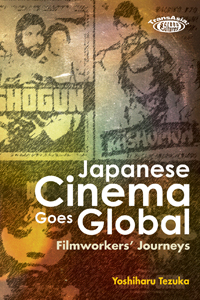 Japanese Cinema Goes Global: Filmworkers’ Journeys
Japanese Cinema Goes Global: Filmworkers’ Journeys
Year: 2012
Author: Yoshiharu Tezuka
ISBN: 9789888083336
Japan’s film industry has gone through dramatic changes in recent decades, as international consumer forces and transnational talent have brought unprecedented engagement with global trends. With careful research and also unique first-person observations drawn from years of working within the international industry of Japanese film, the author aims to examine how different generations of Japanese filmmakers engaged and interacted with the structural opportunities and limitations posed by external forces, and how their subjectivity has been shaped by their transnational experiences and has changed as a result. Having been through the globalization of the last part of the twentieth century, are Japanese themselves and overseas consumers of Japanese culture really becoming more cosmopolitan? If so, what does it mean for Japan’s national culture and the traditional sense of national belonging among Japanese people?
Contents:
Preface
Acknowledgements
Note on Romanization of Asian Names and Scripts
Introduction
Chapter One: Japanese National Identity and “Banal” Cosmopolitalization
- The Crisis of National Identity
The Formation of Different Types of Cosmopolitan Subjectivity
Chapter Two: Internationalization of Japanese Cinema — How Japan Was Different from the West and above Asia before Globalization
- The Occupation, Japanese National Cinema and Industry
- A New Set of Lies — Post-war National Subjectivity
- Legitimizing Cosmopolitanism and Self-Orientalism
- Technology and Japan’s Oriental-Orientalism in Asia
- The Golden Age of the Hong Kong-Japanese Cinematic Interchange
- The Emergence of Resistance Cosmopolitanism
Chapter Three: Globalization of Film Finance — The Actually Existing Cosmopolitanisms of Japanese Film Producers
- Banal Cosmopolitanization and the Mini-Theatres
- Globalizing Japanese Cinema — Reticent Legitimizing Cosmopolitanism
- The Precarious Life of a Japanese Resistance Cosmopolitan in Europe
- Japanese Alternative Cinema and Cosmopolitanism
Chapter Four: Global America? — American-Japanese Film
Co-Productions from Shogun (1980) to The Grudge 2 (2006) via Lost in Translation (2003)
- The Production of Shogun (1980)
- The Japanese Line Producer of Shogun — Hiroaki Fujii
- The Production of Lost in Translation (2003)
- The Japanese Line Producer of Lost in Translation — Kiyoshi Inoue
- Comparing the Two Films and the Two Japanese Line Producers
- Remaking Global Hollywood — Synopticon Control of Locals
Chapter Five: Pan-Asian Cinema? — The Last of Japan-Centred
Regional Cosmopolitanism
- The Japan-Hong Kong Interaction since the Late 1980s
- Working In-between Japan and Hong Kong
- The Undercurrent of Japan-China Interaction
- Hybrid Regionalism Practised by East Asian Film Students
Epilogue
Notes
List of Recorded Interviews
References
Index
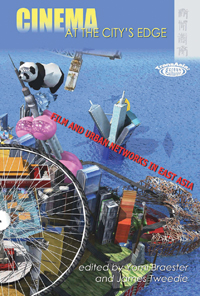 Cinema at the City’s Edge: Film and Urban Networks in East Asia
Cinema at the City’s Edge: Film and Urban Networks in East Asia
Year: 2010
Editors: Yomi Braester and James Tweedie
ISBN: 9789622099845
This anthology presents a number of leading voices on contemporary Asian cinema studies, including Ackbar Abbas, Chris Berry, Emilie Yueh-yu Yeh, Darrell William Davis, Dudley Andrew, Yomi Braester, Susie Jie Young Kim, Akira Mizuta Lippit, James Tweedie, Yiman Wang and Zhang Zhen. Through a range of interdisciplinary responses that simultaneously investigate film practices and technologies, the contributors offer a timely look at the ever-shifting cities in East Asia and their portrayal in cinema.
Contents:
Acknowledgments
List of Contributors
Introduction: The City’s Edge (James Tweedie and Yomi Braester)
• interlude 1: Arriving in the City; Touring the City; Watching the City (Yomi Braester)
Part I. The City Vanishes
1. Affective Spaces in Hong Kong/Chinese Cinema (Ackbar Abbas)
2. Ghost Towns (Dudley Andrew)
• interlude 2: Workspace (James Tweedie)
Part II. A Regional Network of Cities
3. Taipei as Shinjuku’s Other (Emilie Yueh-yu Yeh)
4. City of Youth, Ocean of Death:
Taiyo¯zoku on the Edge of an Island (Yiman Wang)
• interlude 3: Neon (James Tweedie)
Part III. The City of Media Networks
5. Transfiguring the Postsocialist City: Experimental Image-Making in Contemporary China (Zhang Zhen)
6. Noir Looks and the Flash of Transgression: Trauma and the City’s Edge(s) in A Bittersweet Life (Susie Jie Young Kim)
7. Technology and (Chinese) Ethnicity (Darrell William Davis)
• interlude 4: In the Name of the City (Yomi Braester)
Part IV. The City Is Elsewhere
8. Imaging the Globalized City: Rem Koolhaas, U-thèque, and the Pearl River Delta (Chris Berry)
9. At the Center of the Outside: Japanese Cinema Nowhere (Akira Mizuta Lippit)
Notes
Index
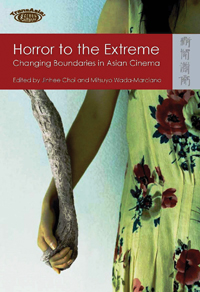 Horror to the Extreme: Changing Boundaries in Asian Cinema
Horror to the Extreme: Changing Boundaries in Asian Cinema
Year: 2009
Editors: Jinhee Choi and Mitsuyo Wada-Marciano
ISBN: 9789622099739
This book compares production and consumption of Asian horror cinemas in different national contexts and their multidirectional dialogues with Hollywood and neighboring Asian cultures. Individual essays highlight common themes including technology, digital media, adolescent audience sensibilities, transnational co-productions, pan-Asian marketing techniques, and variations on good vs. evil evident in many Asian horror films. Contributors include Kevin Heffernan, Adam Knee, Chi-Yun Shin, Chika Kinoshita, Robert Cagle, Emilie Yeh Yueh-yu, Neda Ng Hei-tung, Hyun-suk Seo, Kyung Hyun Kim, and Robert Hyland.
Contents:
List of Contributors
Introduction (Jinhee Choi and Mitsuyo Wada-Marciano)
I. Contesting Genres: From J-horror to “Asia Extreme”
1. J-horror: New Media’s Impact on Contemporary Japanese Horror Cinema (Mitsuyo Wada-Marciano)
2. A Cinema of Girlhood: Sonyeo Sensibility and the Decorative Impulse in the Korean Horror Cinema (Jinhee Choi)
3. Inner Senses and the Changing Face of Hong Kong Horror Cinema (Kevin Heffernan)
4. The Pan-Asian Outlook of The Eye (Adam Knee)
5. The Art of Branding: Tartan “Asia Extreme” Films (Chi-Yun Shin)
II. Contextualizing Horror: Film Movement, National History, and Taboo
6. The Mummy Complex: Kurosawa Kiyoshi’s Loft and J-horror (Chika Kinoshita)
7. The Good, the Bad, and the South Korean: Violence, Morality, and the South Korean Extreme Film (Robert L. Cagle)
8. Magic, Medicine, Cannibalism: The China Demon in Hong Kong Horror (Emilie Yueh-yu Yeh and Neda Hei-tung Ng)
III. Iconography of Horror: Personal Belongings, Bodies, and Violence
9. That Unobscure Object of Desire and Horror: On Some Uncanny Things in Recent Korean Horror Films (Hyun-suk Seo)
10. “Tell the Kitchen That There’s Too Much Buchu in the Dumpling”: Reading Park Chan-wook’s “Unknowable” Oldboy (Kyung Hyun Kim)
11. A Politics of Excess: Violence and Violation in Miike Takashi’s
Audition (Robert Hyland)
Notes
Bibliography
Index
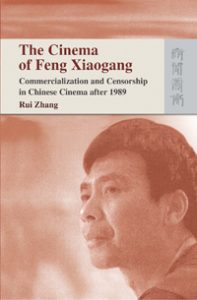 The Cinema of Feng Xiaogang: Commercialization and Censorship in Chinese Cinema after 1989
The Cinema of Feng Xiaogang: Commercialization and Censorship in Chinese Cinema after 1989
Year: 2008
Author: Rui Zhang
ISBN: 9789622098862
Beginning first as a case study of Feng Xiaogang, this book explores Chinese film history since the early 1990s in terms of changes of the Communist Party’s film policy, industry reforms, the official promotion of Main Melody films and the emergence and growth of popular cinema. The image of Feng that will emerge in this book is of a filmmaker working under political and economic pressures in a post-socialist state while still striving to create works with a personal socio-political agenda. In keeping with this reality, this book approaches Feng as a special kind of film auteur whose works must be interpreted with attention to the specific social and political context of contemporary China.
The book will be a useful reference tool for students and scholars in the fields of Chinese studies, Chinese film history and film studies. It could also be used as textbook for classes about Asian cinema, international cinema and Chinese culture/film studies. The extensive use of data about the Chinese film market, and elaborate analysis of the situation of Chinese film industry make this book a valuable volume for classroom and personal use.
Contents:
Acknowledgments
Chapter 1: Introduction
Chapter 2: Chinese Cinema on the Eve of the Tian’anmen Incident
Chapter 3: Chinese Cinema from 1989 to the Middle of the 1990s and
Feng Xiaogang’s Early Career
Chapter 4: New Year Films and Chinese Cinema at the End of the 1990s
Chapter 5: The “Corporate Era” of Chinese Cinema in the New Millennium
and Feng’s Post-New Year Productions
Chapter 6: Conclusion
Notes
Filmography
Selected Bibliography
Index
